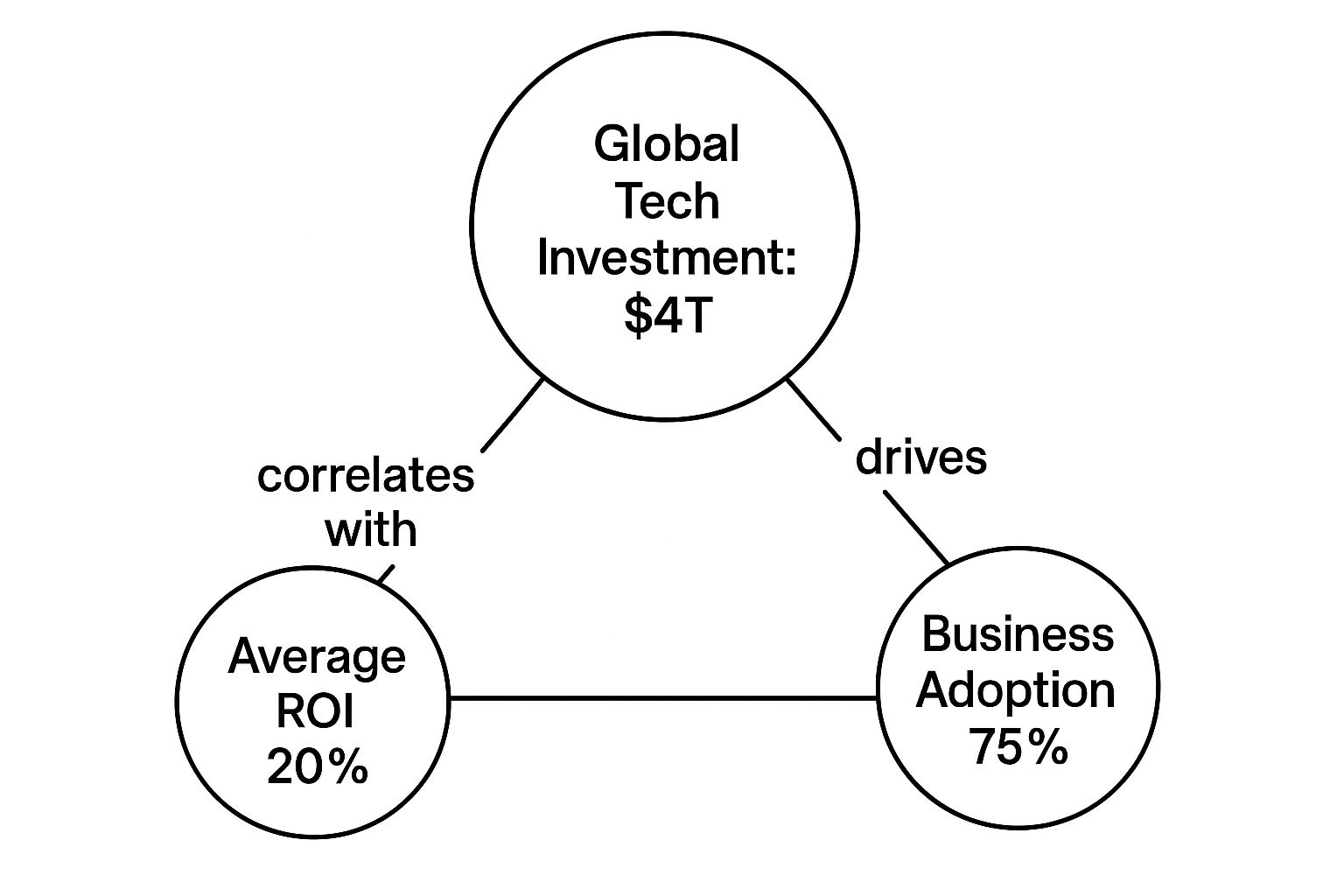Investing in technology is not just about buying the latest software. It is about strategically channelling capital into the tools, systems, and software that will genuinely improve your efficiency, sharpen your capabilities, and fuel real growth. A smart investment in technology delivers measurable returns by freeing up your people's time, enabling better decisions, and ultimately building a more resilient and capable organisation.
Why Your Technology Investment Approach Must Change
Too many leaders fall into the same trap. They see a flashy piece of software as a silver bullet, believing it will magically solve deep-rooted operational problems. The reality? An expensive, underused platform, frustrated teams, and the same old inefficiencies now hiding under a shiny digital veneer. We see this all the time. This 'tool-first' approach is a fast track to wasted time and money.
At Yopla, we are candid about this because we have seen it derail far too many well-intentioned leaders. The fundamental problem is that technology, on its own, solves nothing. It is an enabler, a catalyst—but never the cure. Real, lasting change only happens when you tackle the human and process challenges first. It all starts with asking better questions.
Rethinking The Starting Point
Instead of asking, "What software should we buy?" try asking this: "What daily frustrations are holding our people back?"
That simple shift in perspective reframes the entire exercise. It moves the conversation away from features and platforms and directs it toward outcomes and people. Suddenly, the goal is not just to implement a new system.
It is to:
- Reclaim valuable time for your strategic thinkers by automating soul-crushing repetitive tasks.
- Enable sharper decisions by providing clear, shared insights across every team.
- Build lasting capability so your people can own and drive their own operational improvements long after we are gone.
We believe true transformation starts with people, not platforms. By cutting through the operational fog and clarifying decisions, you ensure technology serves your team, not the other way around. This is the foundation of a modern, capable business.
The following chart paints a clear picture of the global landscape of tech spending, adoption, and the often-disappointing returns.

It shows that while global investment is massive and adoption is widespread, the return on that spend is far from guaranteed. In fact, it is often modest. This gap between spending and meaningful ROI highlights exactly why a more strategic, people-centric approach is so critical. Investing without a clear plan tied to human needs is, frankly, just a gamble.
To help illustrate this shift, here is how we see the two approaches side-by-side.
Shifting from a Tool-First to a People-First Investment Mindset
This table is not just a theoretical model. It is a reflection of what we see work in the real world. Moving from the left column to the right is the single most important step you can take to de-risk your technology investments.
In the rest of this guide, we will show you how to make your next investment in technology count. We will walk you through defining your strategy, uncovering the hidden costs most people miss, measuring what truly matters, and building the internal skills needed for genuine digital sovereignty. This is about rewiring your organisation for sustained success—not just buying another tool.
How to Define Your Strategy Before Spending a Penny
Jumping into vendor demos without a clear strategy is a recipe for wasted time and money. It is all too easy to get dazzled by a compelling sales presentation, lose sight of the real issue, and end up with a solution that does not actually solve your core business problems. Before you even think about specific technologies, you need to get to grips with the human and process challenges you are trying to fix. It is the only way to ensure your investment in technology delivers a real, tangible return.
We have seen it time and again: every successful project starts with people and process, not platforms. This means asking some uncomfortable but essential questions to cut through the operational fog and build a shared vision of what success looks like—one that is grounded in how your teams actually work day-to-day.

Start with the Right Questions
Before you start looking outwards at what vendors are offering, you need to look inwards. Get your leaders and key change-makers in a room. A clear diagnosis is the first step towards an effective cure.
Kick things off with these critical questions:
- Where are our biggest operational bottlenecks? Pinpoint exactly where work slows down, gets stuck, or demands frustrating manual workarounds.
- What daily frustrations are holding our people back? Your team knows where the pain is. Their small, daily irritations often point to much bigger, systemic problems.
- If our teams had two extra hours each day, what would they do with it? This is not just about efficiency; it is about connecting technology to strategic value, moving beyond just ticking off tasks.
- What information do we wish we had but cannot easily access? Identifying data silos and blind spots will tell you exactly what any new system must deliver to enable smarter, faster decisions.
Answering these questions honestly builds the bedrock of your technology strategy. It shifts the entire conversation from "buying a tool" to "solving a problem." This clarity is your best defence against being swayed by flashy features that offer no real value to your organisation.
By defining your objectives with your people first, you guarantee that any technology investment directly addresses a real, identified need, not just market hype. This foundational step is non-negotiable for improving how your business truly operates.
Having these conversations is the first step in a more structured approach. To see how these initial insights fit into a broader plan, you can learn more about how we develop a comprehensive business and technology strategy that aligns your entire organisation. This foundational work ensures that every decision that follows—from vendor selection to implementation—is tied to a clear, people-centric goal. It is what prevents costly missteps and makes sure your investment genuinely improves how your organisation functions, freeing up time and building sustainable capability for the future.
Uncovering The Hidden Costs Of New Technology
That shiny new piece of software? The sticker price is rarely the final bill. In fact, it is often just the tip of the iceberg. A genuine investment in technology goes way beyond the initial licence fee, pulling in a whole range of expenses that are all too easy to overlook. And if you do not see them coming, they can quickly derail your project and your budget.
Too many leaders get caught out by these hidden costs, leading to serious financial strain and, in some cases, outright project failure. Simply ignoring them is a critical mistake. To make a smart, sustainable investment, you need to have a frank, transparent conversation about the total cost of ownership (TCO) right from the very beginning.

Looking Beyond The Licence Fee
The real cost of new technology is a messy combination of direct and indirect expenses. If you do not plan for them properly, they can escalate dramatically, turning a promising initiative into a financial black hole. Thinking about these factors upfront is not just a good idea—it is non-negotiable.
Here are some of the most common hidden costs you absolutely have to account for:
- Implementation and Integration. This is often the biggest offender. It covers all the technical heavy lifting needed to get the new system up and running. More importantly, it includes the work to connect it with the tools you already use, like your CRM or finance software. Without seamless integration, you just end up creating new data silos and a whole lot more manual work for your team.
- Training and Adoption. You cannot just hand people a new tool and expect magic to happen. Proper training takes time and money. Think initial workshops, ongoing support, and, crucially, the cost of lost productivity while your team gets up to speed.
- Ongoing Maintenance and Support. That subscription fee is just the beginning. You also need to budget for vendor support packages, inevitable upgrades, and the internal staff time it will take to manage and maintain the system over its entire life.
- Customisation. Off-the-shelf software is almost never a perfect fit. Any tweaks you need to make it work for your specific processes will add significant development costs, both at the start and every time an update rolls out.
The total cost of a technology project is often 2-5 times the initial purchase price once you factor in all associated services and internal efforts. Budgeting for only the software itself is setting your project up to fail.
We have seen organisations get this spectacularly wrong by focusing only on the vendor's price tag. One client chose a powerful but incredibly complex platform because the licence was cheaper than a competitor’s. They completely failed to budget for the extensive, specialist customisation and training it required. The project stalled for six months while they scrambled to find more funding. The ‘cheaper’ option ended up costing them almost double.
It is a depressingly common story, and it is a stark reminder that you need a full financial and operational commitment. For a deeper dive into the data that informs our own approach, you can explore our latest technology investment research. By understanding the full picture from the outset, you can ensure your investment is built to last and that your organisation is truly ready for the journey ahead.
Measuring the True Return on Your Technology Investment
So, you have made a big investment in new technology. How do you actually know if it is paying off? If you are only looking at a standard Return on Investment (ROI) calculation, you are missing the point. A simple cost-saving number barely scratches the surface. It is a narrow, outdated view that completely ignores the most valuable outcomes: giving your best people their time back, enabling higher-quality decisions, and seeing a real lift in team morale.
To justify any significant spend, you have to move beyond the balance sheet. It is time to adopt a more holistic, people-first way of measuring success. That means tracking improvements that make a tangible difference to your team’s daily grind.
Beyond the Balance Sheet
We always push our clients to start speaking in outcome-based language. Forget just tallying up the cost savings from a new system for a moment. Instead, think about the strategic value of reclaiming ten hours a week for your leadership team. What could they actually do with that time? This simple shift reframes the entire conversation around the real-world impact on the people who drive your business forward.
Start tracking metrics that reflect these real-world improvements:
- Time Reclaimed: How many hours were people wasting on manual, repetitive tasks before the new tech was in place? Measure the difference.
- Decision Velocity: How much faster can your teams get the data they need to make important calls?
- Employee Engagement: You do not need a massive survey. Just ask them. Use simple pulse checks to find out if the new tools have reduced daily frustrations or made their work more meaningful.
- Process Throughput: Are you completing more orders, projects, or tickets without having to hire more people? That is a win.
This kind of thinking is becoming non-negotiable, especially with the rise of new technologies. A recent UK industry survey, for example, showed a huge jump in the tech budget share being pumped into generative AI. From travel to finance, businesses are boosting their AI spend not just to trim costs, but to fuel innovation and productivity. You can see how generative AI is reshaping UK investment priorities for yourself. It is a clear signal that success is now measured by enhanced capabilities and a sharper competitive edge.
Measuring the true ROI of technology is not just about the numbers you can stick on a spreadsheet. It is about proving you have made your organisation more capable, your decisions sharper, and your team’s time more valuable.
A Practical Example of Holistic ROI
Let’s say you invest in a new project management platform. The traditional ROI approach would probably focus on the money you saved by cancelling three other overlapping software subscriptions. That is a decent start, but it is nowhere near the full story.
A people-first measurement model would dig deeper and also track things like:
- A 25% reduction in time wasted in status update meetings. That is senior-level time now freed up for actual strategic work.
- A 50% faster turnaround on client proposals because all the information is finally in one place, easy for anyone to find.
- Genuine positive feedback from team members who are just relieved they no longer have to chase down colleagues for basic information.
This approach paints a much richer, more accurate picture of the value you have created. It proves your investment in technology did not just save a bit of money; it made your entire operation more open, efficient, and ultimately, more sustainable.
Building Internal Capability for Digital Sovereignty
Any investment in technology worth its salt is more than just a one-off transaction. It is the start of an evolution. Far too many consultancies deliver complex systems and then walk away, leaving you tethered to their expensive support contracts. Frankly, we see that as a fundamental failure. Real, lasting value comes from building what we call digital sovereignty—where the expertise and ownership of your technology live inside your own organisation.
Our copilot approach is built for this. We do not just parachute in, install tools, and leave. We work shoulder-to-shoulder with your team to transfer knowledge, build their confidence, and embed skills that stick. The goal is simple: we want your people to feel completely in control of your tech stack long after we are gone.
From Implementation to Ownership
This handover of ownership is the most critical piece of any long-term technology strategy. It is about more than just a few training sessions; it is about building a culture of continuous learning around your new tools. We turn the implementation process itself into a massive growth opportunity for your team.
This does not happen by accident. We make it happen with a few deliberate steps:
- Finding your internal champions. We identify the people in your team who have the spark to become the go-to experts and biggest advocates for the new technology.
- Structuring training that actually works. Our training is not about ticking off features. It is laser-focused on solving the specific, day-to-day problems your team is up against.
- Making knowledge transfer transparent. We use tools like our Plans Portal to make sure every scrap of project documentation, every decision, and every process map is visible and accessible. It becomes a permanent knowledge base for your organisation.
A technology investment only pays off if it empowers your people. The ultimate measure of our success is when your team no longer needs us. That is genuine digital sovereignty.
This focus on building up internal skills is also vital for national competitiveness. While the UK government has announced boosts to R&D spending, some analysis suggests it might only just keep pace with inflation. Worse, a lot of that new funding is aimed at startups, not the broad upskilling that established businesses desperately need. This puts the onus on private companies to take the lead in building their own digital muscle. You can get a sense of the bigger picture by reading the analysis of UK tech investment and innovation ambitions.
Our approach ensures your investment delivers returns year after year. By building a rock-solid foundation of in-house knowledge, you create a far more resilient and self-sufficient organisation. This is how a simple project becomes a lasting operational upgrade. To see exactly how we manage this transition, take a look at our approach to successful technology implementation.
Your Next Steps Toward a Smarter Technology Investment

Alright, you have got the principles down. Now it is time to move from knowing to doing. A truly smart tech strategy is not some vague "digital journey." It is a series of deliberate, well-aimed steps that create momentum and deliver real, tangible results for your people.
For leaders ready to bring their organisation into the modern era, the path forward begins with a bit of honest self-assessment. It is about taking a clear-eyed look at where you are today to get a real sense of where you need to go next. This clarity is the bedrock of any worthwhile investment in technology.
A Simple Roadmap for Action
Before you even glance at a vendor's website or sit through a single product demo, pause and reflect on your organisation’s current state. This is not about a massive, time-consuming audit. It is about building a shared understanding of your most urgent challenges and biggest opportunities.
Use this simple checklist to get the ball rolling with your leadership team:
- Assess Digital Maturity. Honestly, on a scale of 1 to 10, how comfortable and capable is your team with your current core tech? Getting a frank answer here uncovers potential adoption roadblocks before they have a chance to trip you up.
- Identify Operational Friction. Pinpoint the top three processes that cause the most daily frustration or chew up the most time. These are often the perfect candidates for a high-impact, quick-win project.
- Clarify Strategic Goals. What is the single most important business objective you need to hit in the next 12 months? Any tech investment has to be a direct line to achieving that goal.
We have found that the most powerful transformations often ignite from a single, provocative question. Ask your team this: ‘If we could wave a magic wand and eliminate one major source of operational friction tomorrow, what would it be?’
The answers you get will be incredibly telling. They will cut right through the noise and highlight the problems that genuinely matter to the people on the ground, doing the work. That is the human-centric data you need to make a genuinely smart decision.
This targeted approach mirrors a wider trend. The UK's Department for Business and Trade recently reported strong foreign investment in key tech hubs like Edinburgh and Warwick, especially in AI and fintech. It is a clear signal of sustained international confidence in a modern, focused industrial strategy. You can dive into the full story of the UK's recent tech FDI successes to see how directed capital is fuelling job creation.
Real progress does not start with a grand, complicated plan. It starts with a simple, focused conversation about your people, your processes, and your goals. We are here to help you find that clarity, ensuring your next move is a confident step toward a more open, capable, and operationally sustainable organisation.
Frequently Asked Questions
Jumping into any big technology investment can feel like a minefield. Over the years, we have found that leaders tend to hit the same walls and ask the same questions. Here are some straight-talking, practical answers based on our people-first approach.
What Is The Biggest Mistake Leaders Make With Technology Investment?
The single most common and expensive mistake? Falling in love with the technology before truly understanding the human problem it is meant to solve. Too many leaders get dazzled by a new platform’s shiny features without first sitting down to map out the specific operational snags or team frustrations they need to fix.
This 'solution-first' thinking almost guarantees poor adoption and a squandered budget. A winning strategy always, always starts with your people and their daily grind. First, get crystal clear on the problem, and only then go hunting for the tech that fits.
How Do We Get Our Team To Actually Use New Technology?
User adoption is not something you bolt on at the end. It is baked in from day one. It all comes down to involvement and honest communication. Instead of just dropping a new tool on your team, pull them into the selection process. Ask them: what is your biggest headache right now? What would genuinely make your work less of a slog?
Once you have chosen a tool, frame the entire story around ‘what’s in it for them’. Show them exactly how it will kill off tedious tasks, free up their time, or make working together smoother. Back this up with structured, role-specific training that actually makes sense for their day-to-day.
The real secret sauce? You absolutely must find internal champions to lead the charge and ensure senior leaders are actively using the new tech themselves. Real adoption is about co-creation and visible commitment, not a top-down order. It shows you respect your team’s expertise and proves the solution was built for them.
Our Budget Is Limited How Can We Make A Meaningful Investment?
You do not need a massive budget to make a real difference. The trick is to start small and be brutally selective. Forget about a complete operational overhaul for now. Instead, pinpoint the one critical process that is causing the most pain or sucking up the most time.
Find a specific, affordable tool to fix just that one thing. It could be a simple project management app to get teams on the same page, or an automation tool to wipe out hours of mind-numbing data entry each week.
A small, successful project delivers a clear, measurable ROI. This not only solves a genuine problem but also builds the momentum and internal trust you will need for bigger, more ambitious investments down the road. The key is to be strategic and hit the highest-impact area first.






